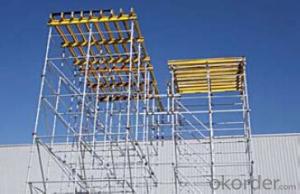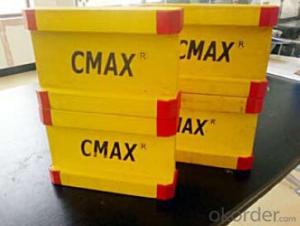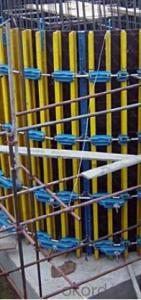RingLock Scaffolding Accessories for Formwork and Scaffolding System
- Loading Port:
- Tianjin
- Payment Terms:
- TT OR LC
- Min Order Qty:
- 50 m²
- Supply Capability:
- 1000 m²/month
OKorder Service Pledge
Quality Product, Order Online Tracking, Timely Delivery
OKorder Financial Service
Credit Rating, Credit Services, Credit Purchasing
You Might Also Like
Ring-lock Scaffolding
A support system for construction, ownsadvantages of both cup-lock scaffolding andshoring tower.
It is in the development direction of new typescaffolding.
It is widely used in buildings, bridges, tunnels etc..
Characteristics:
◆ Easy to storage and transportation
◆ High degree of standardization
◆ Easy and quick erection
◆ Excellent stability and bearing capacity


- Q: What are the weight limits for steel formwork panels?
- Several factors, including panel thickness, dimensions, steel type, and project requirements, can cause weight limits for steel formwork panels to vary. Steel formwork panels are typically built to endure heavy loads and offer structural support while concrete is being poured and cured. Nevertheless, it is crucial to consult the manufacturer or supplier for precise weight limits and load-bearing capacities. They can provide comprehensive technical specifications and guidelines to ensure the secure and effective utilization of the panels at construction sites.
- Q: What are the main components of a steel formwork system?
- The main components of a steel formwork system are the steel panels, walers, stiffeners, and connectors. 1. Steel Panels: These are the primary components of a steel formwork system. They are typically made of high-quality steel and come in various sizes and shapes. Steel panels provide the necessary strength and rigidity to hold the concrete in place during the construction process. They are designed to be easily assembled and disassembled, allowing for efficient use on different construction projects. 2. Walers: Walers are horizontal beams or rods that are used to connect and brace the steel panels. They help distribute the load of the concrete and provide additional strength to the formwork system. Walers are usually made of steel or timber and are placed along the edges of the formwork to maintain its shape and prevent any deformation. 3. Stiffeners: Stiffeners are vertical or diagonal members that are added to the steel formwork system to increase its stability and resistance to lateral forces. They are typically made of steel and are placed at regular intervals to provide additional support and prevent any buckling or twisting of the formwork system. Stiffeners are essential for ensuring the safety and integrity of the formwork during the pouring and curing of the concrete. 4. Connectors: Connectors are used to securely fasten the steel panels and other components of the formwork system. They can include various types of bolts, nuts, clamps, or pins. Connectors play a crucial role in maintaining the alignment and stability of the formwork, ensuring that it can withstand the pressure exerted by the wet concrete. They are designed to be easily adjustable and removable, allowing for quick assembly and disassembly of the formwork system. Overall, a steel formwork system is composed of steel panels, walers, stiffeners, and connectors. These components work together to provide the necessary strength, stability, and flexibility required for the construction of concrete structures. The use of steel in the formwork system ensures durability, reusability, and ease of assembly, making it a popular choice in the construction industry.
- Q: What materials are used in steel formwork construction?
- Steel formwork construction primarily involves the use of steel sheets, beams, angles, channels, brackets, and fasteners, such as bolts and screws.
- Q: What is the difference between the steel template and the assembled steel template?
- Stereotypes templates such as 1200*2001500*300 and so on and the combination of steel template is the use of these provisions of the steel template to be spliced into the target combination template.
- Q: Can steel formwork be used in cultural or entertainment facility construction projects?
- Cultural or entertainment facility construction projects can indeed utilize steel formwork. This type of formwork possesses various advantages, including durability, strength, and the ability to withstand heavy loads. These characteristics make it a suitable choice for constructing the large and intricate structures commonly found in cultural and entertainment facilities, such as theaters, concert halls, museums, and stadiums. Furthermore, steel formwork can be easily tailored to meet the specific design requirements of these facilities, thereby offering flexibility and efficiency during the construction process. Additionally, the reusability of steel formwork contributes to cost savings and a reduced environmental impact. In conclusion, considering its strength, durability, flexibility, and cost-effectiveness, steel formwork presents itself as a viable option for cultural or entertainment facility construction projects.
- Q: What are the common types of steel used for formwork?
- The specific application and requirements determine the common types of steel used for formwork. However, in formwork construction, several types of steel are commonly utilized. 1. Mild Steel: This type of steel is frequently employed in formwork due to its affordability, accessibility, and ease of manipulation. With a low carbon content, mild steel is relatively pliable and can be easily bent or shaped. Nevertheless, it may not be suitable for heavy-duty or high-stress applications. 2. High Tensile Steel: Also known as high-strength steel, high tensile steel is a sturdier and more resilient alternative to mild steel. It contains alloys that enhance its tensile strength, making it perfect for heavy-duty formwork applications that involve higher loads or stresses. Although high tensile steel is more expensive than mild steel, it offers superior structural integrity. 3. Stainless Steel: In formwork applications where corrosion resistance is crucial, stainless steel is often employed. With a high chromium content, it forms a protective layer on the surface, preventing rust and corrosion. Stainless steel is commonly used in marine or coastal construction projects, as well as in areas with high humidity or chemical exposure. 4. Reinforcing Steel: Also known as rebar, reinforcing steel is frequently used in reinforced concrete formwork. It comprises steel bars or mesh embedded within the concrete to provide additional strength and stability. Reinforcing steel is typically made of carbon steel, but stainless steel rebar is also available for applications that require corrosion resistance. When selecting the appropriate type of steel for formwork, it is important to consider factors such as load requirements, environmental conditions, and budget constraints. Consulting with a structural engineer or construction professional can help ensure the right steel type is chosen for the specific project.
- Q: Can steel formwork be used for both vertical and horizontal concrete structures?
- Yes, steel formwork can be used for both vertical and horizontal concrete structures. Steel formwork is highly versatile and can be easily adjusted and assembled to create various shapes and sizes for different structures. It provides strong support, stability, and durability, making it suitable for both vertical walls and horizontal slabs. Steel formwork also offers excellent dimensional accuracy, ensuring precise concrete placement and alignment. Additionally, steel formwork is reusable, which makes it a cost-effective option for construction projects that require repetitive use of formwork systems.
- Q: Can steel formwork be used for architectural concrete walls?
- Yes, steel formwork can be used for architectural concrete walls. Steel formwork provides a strong and durable framework that can withstand the pressure of wet concrete and result in smooth and precise finishes. It is commonly used for complex shapes and designs in architectural concrete walls as it allows for flexibility and ease of construction.
- Q: How does steel formwork handle concrete segregation?
- Due to its strength and durability, steel formwork is a popular choice in construction projects. Its role in handling concrete segregation is crucial, as it ensures a homogeneous mixture and prevents the separation of coarse aggregates from the concrete matrix. Concrete segregation occurs when the components of the concrete mixture, such as cement, water, aggregates, and admixtures, separate due to inadequate mixing or improper handling during placement. This can lead to weak spots, reduced strength, and compromised structural integrity. Steel formwork plays several key roles in preventing concrete segregation. Firstly, its rigid structure provides a stable and secure framework that holds the concrete in place during pouring and curing. This stability ensures that the concrete mixture remains intact and does not separate. In addition, steel formwork can be designed with various features to reduce segregation. For instance, tie rods, clamps, or brackets can be added to hold the form panels tightly together, preventing any movement or displacement of the concrete. These connections minimize the likelihood of aggregate separation and maintain a consistent mixture. Furthermore, the smooth surface of steel formwork prevents excessive bleeding and settlement of the concrete, which are common causes of segregation. The lack of surface irregularities or absorbent properties minimizes the escape of water and cement paste, ensuring a more uniform distribution of aggregates within the concrete. Moreover, steel formwork is easily cleaned and maintained, preventing the accumulation of hardened concrete or debris that could lead to segregation issues. Regular cleaning and inspection of the formwork help ensure that the concrete is poured into a clean and well-maintained mold, reducing the chances of segregation. In conclusion, steel formwork is an effective solution for preventing concrete segregation. Its rigid structure, secure connections, smooth surface, and easy maintenance all contribute to preventing the separation of aggregates from the concrete matrix. By utilizing steel formwork, construction projects can achieve a homogeneous and high-quality concrete placement, resulting in superior structural integrity and durability.
- Q: Can steel formwork be used in tunnel construction projects?
- Yes, steel formwork can be used in tunnel construction projects. Steel formwork is a popular choice in tunnel construction due to its durability, strength, and reusability. It provides a robust framework for pouring concrete and helps to achieve precise and accurate dimensions in tunnel construction. Steel formwork can withstand the pressure of the surrounding soil and the weight of the concrete, ensuring the stability and safety of the tunnel structure. Additionally, steel formwork is resistant to corrosion and has a longer lifespan compared to other types of formwork, making it an ideal choice for long-term tunnel construction projects.
Send your message to us
RingLock Scaffolding Accessories for Formwork and Scaffolding System
- Loading Port:
- Tianjin
- Payment Terms:
- TT OR LC
- Min Order Qty:
- 50 m²
- Supply Capability:
- 1000 m²/month
OKorder Service Pledge
Quality Product, Order Online Tracking, Timely Delivery
OKorder Financial Service
Credit Rating, Credit Services, Credit Purchasing
Similar products
Hot products
Hot Searches
Related keywords



















